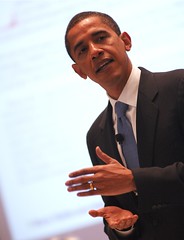 The Democratic presidential contender Barack Obama has released his "New Energy for America" plan. If elected some of the things in his plan are 10% renewables by 2012, one million plug-ins by 2015 and energy efficiency now.
The Democratic presidential contender Barack Obama has released his "New Energy for America" plan. If elected some of the things in his plan are 10% renewables by 2012, one million plug-ins by 2015 and energy efficiency now.
John McCain’s energy plan in comparison is, let’s say, a bit weaker. He is all about nuclear energy, a $300 million battery prize, nothing on energy efficiency and an opposition to clean renewable energy.
Here are some of the energy plans Barack Obama has for America:
Increase Fuel Economy Standards
Obama will increase fuel economy standards 4 percent per each year. The plan is expected to save nearly a half trillion gallons of gasoline and keep 6 billion metric tons of greenhouse gases away from our atmosphere.
Invest in Developing Advanced Vehicles and Put 1 Million Plugin Electric Vehicles on the Road
Obama wants to invest in “advanced vehicle technology with a specific focus on R&D in advanced battery technology†so that 1 million plug-in hybrid/flexible fuel vehicles, "which can get over 150 miles per gallon of gas," could get on the roads by 2015.
To help American consumers switch over to the more eco-friendly cars Obama will "provide a $7,000 tax credit for the purchase of advanced technology vehicles as well as conversion tax credits."
Mandate All New Vehicles are Flexible Fuel Vehicles
"Obama will work with Congress and auto companies to ensure that all new vehicles have FFV capability – the capability by the end of his first term in office". With alternative fuel Obama means "sustainably produced biofuels."
Develop the Next Generation of Sustainable Biofuels and Infrastructure
Besides making all new vehicles have FFV capability Obama will require at least 60 billion gallons of advanced biofuels "are developed and incorporated into our national supply" by 2030.
A sustainability provision will ensure that increased biofuels production does not come at the expense of environmental conservation. This sustainability provision will come from Obama's plans to Establish a National Low Carbon Fuel Standard. "The standard requires fuels suppliers in 2010 to begin to reduce the carbon of their fuel by 5 percent within 5 years and 10 percent within 10 years".
Deploy the Cheapest, Cleanest, Fastest Energy Source -- Energy Efficiency
Obama wants to reduce electricity demand by 15 percent by using the energy generated more efficiently. It is expected that this "will save consumers a total of $130 billion, reduce carbon dioxide emissions by more than 5 billion tons through 2030, and create jobs".
Related to this Obama will Set National Building Efficiency Goals. The goal is to make all new buildings carbon neutral, or produce zero emissions, by 2030. "He'll also establish a national goal of improving new building efficiency by 50 percent and existing building efficiency by 25 percent over the next decade to help us meet the 2030 goal".
"The current Department of Energy has missed 34 deadlines for setting updated appliance efficiency standards, which has cost American consumers millions of dollars in unrealized energy savings." That is why Obama will, if elected, Overhaul Federal Efficiency Standards.
Invest in a Smart Grid
This is, just like it says, smart. "Obama will pursue a major investment in our national utility grid using smart metering, distributed storage and other advanced technologies to accommodate 21st century energy requirements: greatly improved electric grid reliability and security, a tremendous increase in renewable generation and greater customer choice and energy affordability".
Require 10 Percent of Electricity to Come from Renewable Sources by 2012
Obama will "require that 10 percent of electricity consumed in the U.S. is derived from clean, sustainable energy sources, like solar, wind and geothermal by 2012," and 25% by 2025.
Develop and Deploy Clean Coal Technology
Unfortunately Obama hasn't ditched the "clean coal" lie yet.
Safe and Secure Nuclear Energy
Obama wants "key issues" like security of nuclear fuel and waste, waste storage, and proliferation to be addressed before "an expansion of nuclear power is considered." If elected "Obama will make safeguarding nuclear material both abroad and in the U.S. a top anti-terrorism priority. In terms of waste storage, Obama does not believe that Yucca Mountain is a suitable site. He will lead federal efforts to look for safe, long-term disposal solutions based on objective, scientific analysis".
And last but not least Obama will Implement Cap and Trade Program to Reduce Greenhouse Gas Emissions. "Barack Obama supports implementation of an economy-wide cap-and-trade system to reduce carbon emissions by the amount scientists say is necessary: 80 percent below 1990 levels by 2050. This market mechanism has worked before and will give all American consumers and businesses the incentives to use their ingenuity to develop economically effective solutions to climate change. Obama's cap-and-trade policy will require all pollution credits to be auctioned. A 100 percent auction ensures that all industries pay for every ton of emissions they release, rather than giving these valuable emission rights away to companies on the basis of their past pollution. A small portion of the receipts generated by auctioning allowances ($15 billion per year) will be used to support the development of clean energy, invest in energy efficiency improvements, and help develop the next generation of biofuels and clean energy vehicles – measures that will help the economy and help meet the emissions reduction targets".
These are just some of the plans from Barack Obama's energy plan for America. You can read the full plan here (PDF).

Recommended Comments
Join the conversation
You can post now and register later. If you have an account, sign in now to post with your account.